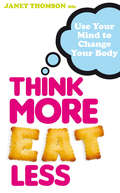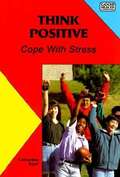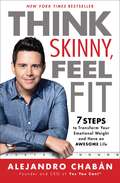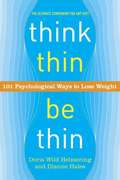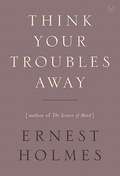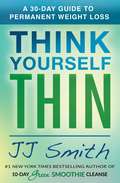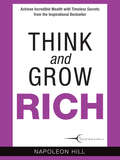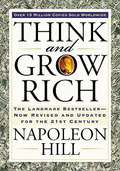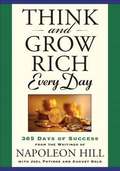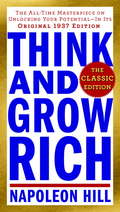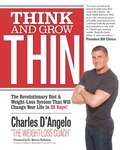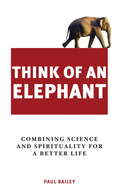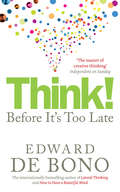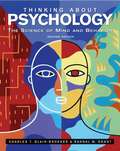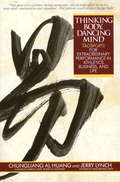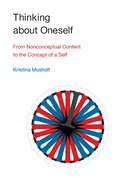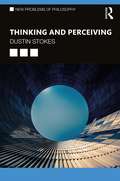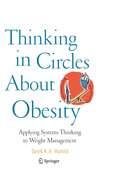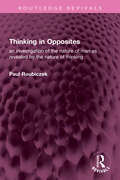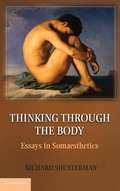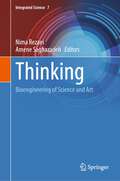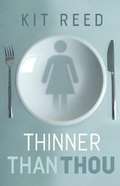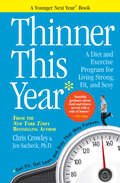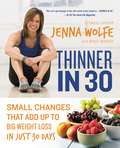- Table View
- List View
Think More, Eat Less: Use Your Mind to Change Your Body
by Janet ThomsonFed up with endless faddy diets that never deliver the results you want, and leave you lunging for the chocolate with a guilty conscience? It's time to stop punishing your body with crazy regimes in the hope that one day it will co-operate, and recognize that to lose weight and change your body, you first have to change how you think. Think More, Eat Less will help you do just that, providing a step-by-step plan to re-programme your thoughts surrounding food. It will also give you an understanding of how your hormones control your body weight and how you can learn to manage them using a unique food system to cleanse your body and burn fat, allowing you to make physical and emotional transformations you never thought possible: a total Mind-Body makeover.
Think Positive: Cope With Stress (Good Health Guidelines)
by Catherine ReefDiscusses stress and how to manage it.
Think Skinny, Feel Fit: 7 Steps to Transform Your Emotional Weight and Have an Awesome Life
by Alejandro ChabánBefore you can lose pounds, you must shed weight.Alejandro Chabán suffered from being overweight as a child and from anorexia and bulimia as an adolescent, and desperately tried to have a healthy body. Then, after trying different diets and exercise regimens, he finally lost 150 pounds. But he discovered that even though his body was thin, in his mind, he was still overweight. This realization inspired him to develop techniques to accept these feelings and transform them into powerful practices. In 2012, this proven method led Alejandro to found Yes You Can!®, a program that has helped thousands of people to follow a healthy lifestyle with a Latin flavor. In Think Skinny, Feel Fit, Alejandro shares for the first time the seven steps that were essential in helping him master his mind in order to transform his body. Using personal anecdotes and examples, Alejandro explains in detail what it means to be emotionally overweight, how emotions and physical well-being are connected, and how best to identify the mental obstacles that weigh down your mind and body. These steps, grounded in positive-thinking techniques, meditation, and self-acceptance and commitment, will help you lead a happier, healthier life. Now you can say "Yes!" to finally taking care of yourself the way you deserve.
Think Thin, Be Thin: 101 Psychological Ways to Lose Weight
by Doris Wild Helmering Dianne HalesIf you’ve been struggling with your weight, you know how hard it can be to lose those extra pounds and keep them off. In the groundbreaking Think Thin, Be Thin, nationally prominent psychotherapist Doris Wild Helmering and award-winning health writer Dianne Hales assert that the true key to a healthy body weight is a healthy attitude toward food and exercise. Their logic is simple: Your brain ultimately controls what you eat and whether you work out. If you change the way you think, you can change the way you behave. And you can lose weight.Using proven psychological strategies and scientifically based exercises, you will learn how to harness your thoughts to transform your behavior, body, and life. With practical advice on such troublesome issues as curbing emotional eating, motivating yourself to exercise, and overcoming diet plateaus, this book is the ideal complement to any diet and weight-loss program.
Think Your Troubles Away
by Ernest HolmesHave you wondered how you can use your mind to experience fewer problems and more joy? The majority of the difficulties people encounter are ones they have created by what they think-consciously or unconsciously. What has been created by one kind of thought can be changed by an opposite thought. In Think Your Troubles Away, Holmes helps each reader understand how the mind works, and the role of the subconscious in our everyday lives. With short, easy-to-read yet profound chapters, Holmes shows us how to get from where we are to where we want to be-using the power of the mind. A small gem, Think Your Troubles Away is more timely now than when it was originally published. .
Think Yourself Thin: A 30-Day Guide to Permanent Weight Loss
by JJ SmithThe author of the #1 New York Times bestseller 10-Day Green Smoothie Cleanse returns with this revolutionary guidebook filled with the crucial mental strategies that will provide the missing piece in your weight loss journey once and for all.After helping dieters lose over two-million pounds in two years, JJ Smith realized the most important, yet most overlooked, factor for permanent weight loss is mental mastery. In Think Yourself Thin, Smith helps you uncover the root of your struggle and address the spiritual or emotional issues tied to your eating behavior. By applying the strategies outlined in this book, you will have the tools you need to take control of your weight, and thus your health, and experience the joy of having your dream body. Divided into four parts, Smith&’s book uncovers the five psychological stages required to lose weight and keep it off. Smith also introduces the all-new SUCCESS System detailing the mental habits and approaches necessary for permanent weight loss. Filled with inspiring, motivational success stories and user-friendly principles that provide the guidance you need to eat in a manner that helps the body burn fat and lose weight, Think Yourself Thin makes long-term weight loss a reality by starting with what matters most.
Think and Grow Rich
by Napoleon Hill Katherine HurstThink and Grow Rich is the wildly successful motivational book from personal development author, Napoleon Hill. Having sold over 30 million copies over the past 70 years alone, this groundbreaking volume reveals the secrets of hundreds of the world's most affluent people - exposing the thought-processes and success mindset that can help you too, to enjoy unlimited prosperity and abundance. The thirteen step program found in this book has everything you need to set you on the path to incredible wealth and success. Regardless of your current circumstances, education or business experience... once you begin to read this book, you'll have access to the truths and lessons that can teach any man or woman - young or old, rich or poor - to turn their dreams for an abundant life into a reality. With this book, the formula for everything you desire - to be applied in ALL areas of life - is in your hands. Simple, direct, but incredibly powerful too - this book has the potential to change your life for the better. Are you ready? The formula for prosperity - to be applied in ALL areas of your life - is within your reach.
Think and Grow Rich
by Napoleon HillThink and Grow Rich has been called the "Granddaddy of All Motivational Literature." It was the first book to boldly ask, "What makes a winner?" The man who asked and listened for the answer, Napoleon Hill, is now counted in the top ranks of the world's winners himself. The most famous of all teachers of success spent "a fortune and the better part of a lifetime of effort" to produce the "Law of Success" philosophy that forms the basis of his books and that is so powerfully summarized in this one. In the original Think and Grow Rich, published in 1937, Hill draws on stories of Andrew Carnegie, Thomas Edison, Henry Ford, and other millionaires of his generation to illustrate his principles. In the updated version, Arthur R. Pell, Ph.D., a nationally known author, lecturer, and consultant in human resources management and an expert in applying Hill's thought, deftly interweaves anecdotes of how contemporary millionaires and billionaires, such as Bill Gates, Mary Kay Ash, Dave Thomas, and Sir John Templeton, achieved their wealth. Outmoded or arcane terminology and examples are faithfully refreshed to preclude any stumbling blocks to a new generation of readers.
Think and Grow Rich
by Napoleon HillHere are money-making secets that can change your life. Inspired by Andrew Carnegie's magic formula for success, this book will teach you the secrets that will bring you a fortune. It will show you not only what to do but how to do it. Once you learn and apply the simple, basic techniques revealed here, you will have mastered the secret of true and lasting success. And you may have whatever you want in life.
Think and Grow Rich Every Day
by Napoleon HillA daily handbook for cultivating abundance and riches-from the classic writings of Napoleon Hill. Think and Grow Rich has sold millions of copies since its initial publication, and is still one of the bestselling books on the market. With 365 quotations from Napoleon Hill's most important works on success and abundance, this daily guide serves as a companion for everyone who wants to experience more prosperity in their lives. Using Hill's idea that each day matters, and that every day offers new opportunities, Think and Grow Rich Every Day is the perfect gift for every reader who wants to turn this groundbreaking philosophy into reality. Using the most potent writings from Hill's books, Think and Grow Rich and The Law of Success, these daily readings will help to turn doubt into confidence, fear into strength, and failure into triumph. .
Think and Grow Rich: The All-Time Masterpiece on Unlocking Your Potential--In Its Original 1937 Edition
by Napoleon HillAn affordable, beautifully produced reproduction of the vintage text of Napoleon Hill's original landmark--this is the legendary program, just as it reached readers in 1937.You want to dip into Think and Grow Rich ... you've heard about it from friends and coworkers ... you see people reading it ... and you feel it's time for a change in life. But where do you start? RIGHT HERE. Think and Grow Rich: The Classic Edition is a handsome, reliable, inexpensive, and compact volume that features the full 1937 text, just as it appeared on its first day of publication, before the book lit up millions of lives and became known around the world. This is a volume you will want to read, reread, cherish--and then share with friends and loved ones. And it is priced so affordably that you can do just that. From the Trade Paperback edition.
Think and Grow Thin
by Charles D'AngeloMillions across this nation have eaten themselves into a prison they can't escape - and with Think and Grow Thin, Charles D'Angelo busts down those walls and unlocks the secrets of weight-loss success. This one-stop comprehensive guide targets your mind more than your muscles to help you battle the mindset that's making you fat. Whether you have 10, 200 or even more pounds to lose, Charles' easy-to-follow success strategies and eating plans will give you the skills and motivation to make weight loss finally work. Filled with inspirational success stories along with photographs. You won't believe your eyes!
Think of an Elephant
by Paul BaileyCombining science and spirituality to reveal the true nature of the universe - this book will change perceptions, inspire mind-shifts and alter the way we see the world, forever.
Think!: Before It's Too Late
by Edward de BonoThe world is full of problems and conflicts. So why can we not solve them? According to Edward de Bono, world thinking cannot solve world problems because world thinking is itself the problem. And this is getting worse: we are so accustomed to readily available information online that we search immediately for the answers rather than thinking about them. Our minds function like trying to drive a car using only one wheel. There's nothing wrong with that one wheel - conventional thinking - but we could all get a lot further if we used all four... De Bono examines why we think the way we do from a historical perspective and uses some of his famous thinking techniques, such as lateral thinking, combined with new ideas to show us how to change the way we think. If we strengthen our ability and raise our thinking level, other areas of our life - both personal and business success - will improve.De Bono is the master of the original big 'concept' book and his enticement to us to use our minds as constructively as possible should appeal to a whole new generation of fans.
Thinking About Psychology: The Science of Mind and Behavior
by David G. Myers Charles T. Blair-Broeker Randal M. Ernst Charlie Blair-Broeker Randy ErnstWritten to promote critical thinking, captivate students, and satisfy the APA standards for high school psychology,Thinking About Psychology is an introduction to high school psychology unlike any other. In a convenient and effective modular format, it presents psychological science in a rigorous yet non-threatening way, with immediate examples that help high school students bridge the abstract to the familiar.
Thinking Body, Dancing Mind: Taosports for Extraordinary Performance in Athletics, Business, and Life
by Chungliang Al Huang Jerry LynchWritten by a sports psychologist and a renowned T'ai Chi master, here is a guide to enriching all of life's pursuits through the practice of its simple mental tools and wisdom. Using stories of success from athletes and businesspeople, the authors present techniques and exercises to promote relaxation and enhance performance.
Thinking about Oneself: From Nonconceptual Content to the Concept of a Self (The\mit Press Ser.)
by Kristina MusholtA novel theory of self-consciousness and its development that integrates philosophical considerations with recent findings in the empirical sciences.In this book, Kristina Musholt offers a novel theory of self-consciousness, understood as the ability to think about oneself. Traditionally, self-consciousness has been central to many philosophical theories. More recently, it has become the focus of empirical investigation in psychology and neuroscience. Musholt draws both on philosophical considerations and on insights from the empirical sciences to offer a new account of self-consciousness—the ability to think about ourselves that is at the core of what makes us human. Examining theories of nonconceptual content developed in recent work in the philosophy of cognition, Musholt proposes a model for the gradual transition from self-related information implicit in the nonconceptual content of perception and other forms of experience to the explicit representation of the self in conceptual thought. A crucial part of this model is an analysis of the relationship between self-consciousness and intersubjectivity. Self-consciousness and awareness of others, Musholt argues, are two sides of the same coin. After surveying the philosophical problem of self-consciousness, the notion of nonconceptual content, and various proposals for the existence of nonconceptual self-consciousness, Musholt argues for a non-self-representationalist theory, according to which the self is not part of the representational content of perception and bodily awareness but part of the mode of presentation. She distinguishes between implicitly self-related information and explicit self-representation, and describes the transitions from the former to the latter as arising from a complex process of self–other differentiation. By this account, both self-consciousness and intersubjectivity develop in parallel.
Thinking and Perceiving (New Problems of Philosophy)
by Dustin StokesHuman beings are in contact with the world through their minds. One can make sensory perceptual contact with the world: One sees the tree and hears its leaves flutter. And one makes cognitive contact with the world: One forms beliefs about the tree, memories of how it was in the past, and expectations of how it will be in the future. Can the first, perception, be influenced in important ways by the second, cognition? Do cognitive states such as memories, beliefs, and expectations affect what one perceives through the senses? And what is the importance of these possible relations to how we theorize and understand the human mind? Possible cognitive influence on perception (sometimes called "cognitive penetration of perception") has been long debated in philosophy of mind and cognitive science: Some argue that such influence occurs, while others argue that it does not or cannot. In this excellent introduction and overview of the problem, Dustin Stokes examines the following: The philosophical and scientific background to cognition and perception Contemporary ways of distinguishing cognition and perception Questions about the representational content of perception versus cognition Distinct theories of mental architecture: modularity versus malleability Consequences for epistemology, philosophy of science, and aesthetics Philosophical and scientific research on perceptual attention Perceptual skill, learning, and expertise Perceptual content, objectivity, and cultural bias. Additional features, such as chapter summaries, suggestions for further reading, and a glossary, make Thinking and Perceiving an ideal resource for students of philosophy of mind and psychology, cognitive psychology, and cognitive science.
Thinking in Circles about Obesity: Applying Systems Thinking to Weight Management
by Tarek K. HamidThinking in Circles About Obesity has been "Highly Commended" in the "Popular Medicine" category of the 2010 BMA Book Awards. Low-carb...low-fat...high-protein...high-fiber...Americans are food-savvy, label-conscious, calorie-aware--and still gaining weight in spite of all their good intentions. Worse still, today's children run the risk of a shorter life expectancy than their parents. Thinking in Circles About Obesity brings a healthy portion of critical thinking, spiced with on-target humor and lively graphics, to the obesity debate. Systems scholar Tarek Hamid proposes that a major shift in perspective is needed to address the problem. This book unites systems (non-linear) thinking and information technology to provide powerful insights and practical strategies for managing our bodies, as well as our health. Applying these creative, business-tested techniques to personal health lets readers approach weight problems like CEOs--not bean-counters!--and connect the elusive links between the biological, environmental, social, and psychological factors that contribute to overweight and obesity, yo-yo dieting and willpower issues. The author's clear insights dispel dieters' unrealistic expectations and illuminate dead-end behaviors to tap into a deeper understanding of how the body works, why it works that way, and how to improve the bottom line. For optimum results, he includes innovative tools for: Understanding why diets almost always fall short of our expectations. Assessing weight gain, loss, and goals with greater accuracy. Abandoning one-size-fits-all solutions in lieu of personal solutions that do fit. Replacing outmoded linear thinking with feedback systems thinking. Getting the most health benefits from information technology. Making behavior and physiology work in sync instead of in opposition. Given the current level of the weight crisis, the ideas in Thinking in Circles About Obesity have much to offer the clinical or health psychologist, the primary care physician, the public health professional the parent and the lay reader. For those struggling with overweight, this book charts a new path in health decision-making, to see beyond calorie charts, Body Mass Indexes, and silver bullets.
Thinking in Opposites: an investigation of the nature of man as revealed by the nature of thinking (Routledge Revivals)
by Paul RoubiczekFirst published in 1952, Thinking in Opposites insists on the need for a carefully thought-out, rather than a merely authoritarian, basis for faith; but also insists that an indispensable preliminary is to know the laws which govern and limit the scope of human thinking in relation to three areas: the external world as it is; the internal world of feeling; and the interrelation of each of these with the other. This book is not a technical work in philosophy and the theory of knowledge; but it deals with problems in those fields which have usually been handled only in technical language. Therefore, this is a book both for the expert and for the intelligent and thoughtful layman: for the man who has a sense of responsibility for what he believes, and who is able to justify his faith amid the chaos of our times.
Thinking through the Body
by Richard ShustermanThis book provides a richly rewarding vision of the burgeoning interdisciplinary field of somaesthetics. Composed of fourteen wide-ranging but finely integrated essays by Richard Shusterman, the originator of the field, Thinking through the Body explains the philosophical foundations of somaesthetics and applies its insights to central issues in ethics, education, cultural politics, consciousness studies, sexuality, and the arts. Integrating Western philosophy, cognitive science, and somatic methodologies with classical Asian theories of body, mind, and action, these essays probe the nature of somatic existence and the role of body consciousness in knowledge, memory, and behavior. Deploying somaesthetic perspectives to analyze key aesthetic concepts (such as style and the sublime), he offers detailed studies of embodiment in drama, dance, architecture, and photography. The volume also includes somaesthetic exercises for the classroom and explores the ars erotica as an art of living.
Thinking: Bioengineering of Science and Art (Integrated Science #7)
by Nima Rezaei Amene SaghazadehThe “THINKING: Bioengineering of Science and Art” is to discuss about philosophical aspects of thinking at the context of Science and Art. External representations provide evidence that the fundamental process of thinking exists in both animal subjects and humans. However, the diversity and complexity of thinking in humans is astonishing because humans have been permitted to integrate scientific accounts into their accounts and create excellent illustrations for the effects of this integration. The book necessarily begins with the origins of human thinking and human thinking into self and others, body, and life. Multiple factors tend to modify the pattern of thinking. They all will come into play by this book that brings thinking into different disciplines: humanities, natural sciences, social sciences, formal sciences, and applied sciences. The thinking demands full processing of information, and therefore, the book considers the economy of thinking as well. The book thoroughly intends to explore thinking beyond the boundaries. Specifically, several chapters are devoted to discipline this exploration either by artistic thinking alone or by art and mathematics-aided engineering of complexities. In this manner, the book models variations on thinking at the individual and systems levels and accumulates a list of solutions, each good for specific scenarios and maximal outcomes.
Thinner Than Thou
by Kit ReedReverend Earl promotes Sylphania, the most luxurious health spa in the world, and helps teenagers achieve the perfect physical appearance. However middle-aged Jeremy discovers the dark secrets of Sylphania.
Thinner This Year: A Younger Next Year Book (Younger Next Year)
by Chris Crowley Jennifer SacheckNow in paperback, the latest book in the New York Times bestselling, one-million-copy-plus Younger Next Year franchise. The book that tells every reader how to lose weight, discover new vitality, and get in the best shape of your life. The book with the no-nonsense, no-BS, no-shortcuts approach. The book that shows that there’s a revolution in aging going on. The book that is the how-to of that revolution.Chris Crowley, the memorable patient and coauthor of Younger Next Year, partners with Jen Sacheck, a nutritionist and fitness expert from Tufts University, and in lively, alternating chapters they spell out a weight-loss plan that will have readers losing up to 25 pounds in the first six months—and, much more significantly, keeping it off next year, and the year after, and so on, for life. The message is straightforward and based on the most up-to-date nutritional science: resist the added-fat, added-sugar concoctions created by the food industry; skip the supplements; pile on fruits and vegetables to your heart’s content, but it’s OK to eat lean meats, too; and don’t drink your calories. And exercise! With its simple, fully illustrated program of 25 “sacred exercises,” here is everything the reader needs to build muscle, protect joints, add mobility, and put off 70% of the normal problems associated with aging and eliminate 50% of serious illness and injury.“Clear, concise, well-balanced nutritious diet plan. Realistic exercise . . . [and] the combo of the authors—nutrition scientist and witty writer—makes this an easy-to-read volume with loads of timely, science-based information.”—Madelyn Fernstrom, Diet and Nutrition Editor, TODAY and NBCNews.com “Chock-full of easy recipes, meal plans, and exercise diagrams.”—The Wall Street Journal
Thinner in 30: Small Changes That Add Up to Big Weight Loss in Just 30 Days
by Myatt Murphy Jenna WolfeA month from now, you'll wish you had started today.Yes, a month is all it takes to see long-term results.And seriously-even YOU can lose that weight!Food and exercise fads come and go, mainly because they just aren't sustainable. After a few days, you're hungry, bored, or hungry AND bored. That's why the Today show's very first lifestyle and fitness correspondent, Jenna Wolfe, created her famous 30-Day Fitness Challenge for her viewers. The challenge was wildly successful because of its unprecedented and simple approach to everyday health and fitness-one small tip a day for 30 days. Now, in THINNER IN 30, Jenna takes her foolproof program to the next level, giving you the tools and motivation you'll need to achieve your wellness goals with thirty small changes that add up to big results-in as few as 30 days. It's all possible without joining a gym, counting calories, or signing up for a trendy class you can't even pronounce. The perfect plan for busy men and women of all ages and fitness levels, THINNER IN 30 puts the focus on small, bite-size tips which lead to long-term weight loss.Jenna blends athletic wisdom, laugh-out-loud humor, and easy-to-follow advice, like how many times to chew your food per bite, what the heck carbs are all about, and how to sneak in workouts without any time, money, equipment, or energy (pretty much covering any excuse you may have). THINNER IN 30 will help you discover just how easy it is to get healthy without having to deprive yourself or work out 12 hours a day.
